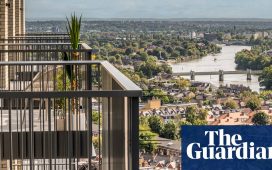The UK’s new Labour government has promised the biggest house building programme in Britain for two generations, and vowed that it will not shy away from confrontation to impose large numbers of additional houses on rural Britain and small regional towns.
Announcing plans to build more than 300,000 new homes a year in England last month — a target last hit in 1977 — chancellor Rachel Reeves promised sweeping reforms to a planning system she said was “a byword for political timidity in the face of vested interests”.
However, planning experts, developers and local politicians say that delivering homes at such scale will require more than just tough talking: equal efforts will be needed to persuade local communities to think less negatively about development.
“Real reform can’t be built on the back of a tired narrative about planning being a blocker,” said Hannah Hickman, associate professor of planning practice at the University of the West of England in Bristol.
“If Labour are serious about really changing things, I believe it’s possible to acknowledge the challenges, whilst simultaneously framing a future debate about the positive power of planning for communities,” she added.
Public opinion is theoretically supportive of Labour’s plan to “get Britain building again” with 62 per cent backing the policy, according to a YouGov poll conducted the day after Reeves delivered her first speech as chancellor — more than double the 29 per cent who oppose it.

But when asked about large amounts of new housing in their own area, public support narrowed to just 52 per cent in favour and 41 per cent against, a sign of the “not in my backyard” or “Nimby” attitudes that have thwarted housebuilding in Britain for decades.
To overcome such opposition, experts and investors say that Labour must employ as much carrot as stick, including significantly increasing the amount of affordable and build-to-rent housing.
Such developments are typically delivered by local authorities and institutional investors who take a longer-term view of development than traditional high-volume housebuilders who retreat once properties are sold.
By contrast, asset management firms such as Legal & General and the Pension Insurance Corporation (PIC), which have branched into rental property development, stay around to manage properties and deliver stable returns from their investments.
At a time of straitened public finances such long term but community-sensitive developments should have a crucial role to play in Labour’s planned building boom, according to Jeremy Apfel, PIC’s managing director of corporate affairs.
The bulk annuity insurance sector in which PIC operates expects to have up to £200bn to invest in UK infrastructure over the next decade. But it is currently short of opportunities because of the challenges of delivering development, Apfel said.
“It will require a new narrative to build consensus — and that means that the social value of infrastructure and regeneration projects needs to be much better understood to usher in a new era of public-private partnerships,” he added.
One such development, the £130mn New Victoria build-to-rent development in Manchester that PIC opened last year on the site of an old railway station car park, is an example of a longer term approach to building that emphasises the “social value” of regeneration.

This is both during the construction phase — which PIC said delivered the equivalent of 2,215 weeks of apprenticeship opportunities and 29 work placements — and afterwards when the 520 homes are rented out.
“It’s a long-term, multi-decade investment,” said Sam Winnard, the head of build-to-rent operations at PIC, which says it wants to create “vertical villages”, with community outreach and social events for residents.
Labour’s plans for new towns and urban extensions will also need to fire the imaginations of the public if they are to avoid meeting resistance, according to Nicholas Boys Smith, founder and chair of Create Streets, a design practice and think-tank.
Boys Smith, who co-authored the Building Better, Building Beautiful Commission report for the Conservative government in 2019, is a proponent of “gentle” density development.
He advocates the use of social media engagement and survey techniques to bring the public into the shaping of the developments planned for their “backyards”, and foster buy-in for places with trees and transport connections that intuitively make sense to local people.
“The principle must be to engage as early as possible and as widely as possible about ‘what’ and ‘where’ to build,” said Boys Smith.


Even though Manchester has become known for a pro-development stance, typified by city centre schemes such as New Victoria, outside of its urban core battles still rage over attempts to build on green spaces.
Less than five miles from New Victoria campaigners have long opposed plans to build 120 homes on a former industrial site that over the years has become a green space used by the community.
Residents argue the city already has enough brownfield for development, an argument likely to be heard in many parts of the country as the new government opens up greenfield or previously undeveloped land for building.
“Nature is in crisis and ordinary people’s access to nature is rapidly diminishing,” said Sarah Benjamin, spokesperson for Save Ryebank Fields, adding that the space earmarked for housing has been “rewilding for 30 years”.
“Our struggle exemplifies one that is happening hundreds if not thousands of times over in urban communities across the UK.”

Meanwhile, attempts to create a joint strategy across all 10 of Greater Manchester’s boroughs to meet the conurbation’s growing housing need have often proved tortuous. Residents in outlying boroughs have opposed the development of greenbelt sites, which Labour’s reforms will bring more pressure on councils to develop.
Nevertheless, Pete Gladwell, group social impact and investment director at institutional investors Legal and General, said that often community opposition is driven by the nature of the proposal, rather than new housing per se.
Too often the approach has been “build as many homes as you can”, he said, without factoring in the public’s expectation of quality homes or additional infrastructure such as health centres, schools and transport links.
“We can end up really focused on opposition, rather than maximising local support,” he said. “People know their kids need homes locally. They just want the right kind of community to be built, rather than some of the kind of things the industry has been churning out the last few years.”













